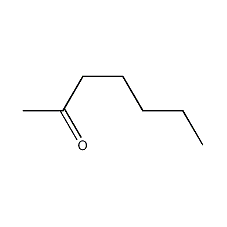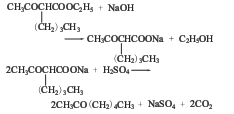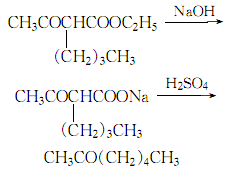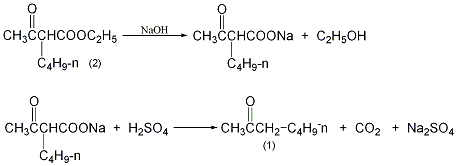
Structural formula
| Business number | 0316 |
|---|---|
| Molecular formula | C7H14O |
| Molecular weight | 114.19 |
| label |
Methyl n-amyl ketone, n-pentyl ketone, 2-Oxoheptane, 1-Methylhexanal, Methyl pentyl ketone, Butylacetone, n-Pentyl methyl ketone, food additives, Flavor enhancer |
Numbering system
CAS number:110-43-0
MDL number:MFCD00009513
EINECS number:203-767-1
RTECS number:MJ5075000
BRN number:1699063
PubChem number:24845299
Physical property data
1. Properties: colorless and transparent liquid with a fruity aroma similar to pear. [1]
2. Melting point (℃): -35.5[2]
3. Boiling point (℃): 151[3]
4. Relative density (water = 1): 0.82[4]
5. Relative vapor Density (air=1): 3.94[5]
6. Saturated vapor pressure (kPa): 0.2 (25℃)[6]
7. Critical pressure (MPa): 2.95[7]
8. Octanol/water partition coefficient: 1.98[8]
9. Flash point (℃): 39[9]
10. Ignition temperature (℃): 393[10 ]
11. Explosion upper limit (%): 7.9[11]
12. Explosion lower limit (%): 1.1 [12]
13. Solubility: Insoluble in water, miscible in most organic solvents. [13]
14. Refractive index (n20ºC): 1.4088
15. Refractive index (n25ºC): 1.4066
16 .Body expansion coefficient (K-1, 10~30ºC): 0.00103
17. Critical density (g·cm-3): 0.262
18. Critical volume (cm3·mol-1): 436
19. Critical compression factor: 0.256
20. Eccentricity factor: 0.413
21. Solubility parameter (J·cm-3)0.5: 17.884
22.van der Waals area (cm2·mol-1): 1.124×1010
23.van der Waals volume (cm3·mol-1): 79.960
24. Liquid phase standard hot melt (J·mol-1·K-1): 241.6
Toxicological data
1. Acute toxicity:
Rat oral LD50: 1670mg/kg; rat inhalation LDLO: 4000ppm/4H;
Rat abdominal LD50: 800mg/kg; Mouse oral LC50: 730mg/kg;
Mouse abdominal LC50: 400mg/kg; Rabbit skin LD50: 12600ul/kg;
2. Other multiple dose data: rat Oral TDLO: 45500mg/kg/13W-I;
3. It is of low toxicity and mainly has anesthetic and stimulating effects. Inhaling its vapor can cause symptoms such as headache, fatigue, dizziness, and anemia. The maximum allowable concentration in the workplace is 466mg/m3.
4. Acute toxicity[14]
LD50: 1670mg/kg (rat Oral); 12600mg/kg (rabbit transdermal)
LC50: 4000ppm (rat inhalation, 4h)
5. Irritation[15] Rabbit transdermal: 14mg (24h), mild stimulation (open stimulation test)
6. Subacute and chronic toxicity[16] Rats and monkeys were exposed to 1000ppm for 9 months, and no neurological symptoms were seen; exposed to 1025ppm, 6 hours a day, 5 days a week, for a total of 10 months, there were no changes in lung function, electrocardiogram and clinical biochemical indicators.
Ecological data
1. Ecotoxicity[17] LC50: 131mg/L (96h) (fathead minnow, dynamic)
2. Biodegradability No information yet
3. Non-biodegradability[18] In the air, when the concentration of hydroxyl radicals is 5.00×105/cm3, the degradation half-life is 4.5h (theoretical).
Molecular structure data
1. Molar refractive index: 34.50
2. Molar volume (cm3/mol): 141.2
3. Isotonic specific volume (90.2K ): 315.7
4. Surface tension (dyne/cm): 24.9
5. Polarizability (10-24cm3): 13.68
Compute chemical data
1. Reference value for hydrophobic parameter calculation (XlogP): None
2. Number of hydrogen bond donors: 0
3. Number of hydrogen bond acceptors: 1
4. Number of rotatable chemical bonds: 4
5. Number of tautomers: 3
6. Topological molecule polar surface area 17.1
7. Number of heavy atoms: 8
8. Surface charge: 0
9. Complexity: 66.8
10. Number of isotope atoms: 0
11. Determine the number of atomic stereocenters: 0
12. Uncertain number of atomic stereocenters: 0
13. Determine the number of chemical bond stereocenters: 0
14. Number of uncertain chemical bond stereocenters: 0
15. Number of covalent bond units: 1
Properties and stability
1. Stability[19] Stable
2. Incompatible substances[20] Strong oxidizing agent, strong reducing agent, strong alkali
3. Polymerization hazard[21] No polymerization
Storage method
Storage Precautions[22] Store in a cool, ventilated warehouse. The storage temperature should not exceed 37°C. Keep away from fire and heat sources. Keep container tightly sealed. They should be stored separately from oxidants, reducing agents and alkalis, and avoid mixed storage. Use explosion-proof lighting and ventilation facilities. It is prohibited to use mechanical equipment and tools that are prone to sparks. The storage area should be equipped with emergency release equipment and suitable containment materials.
Synthesis method
1. Obtained by saponification of ethyl butylacetoacetate: Add ethyl butylacetoacetate to 5% sodium hydroxide solution, stir at room temperature for 4 hours, let stand and separate into layers. The oil layer is the unsaponified raw material. Separate and reuse. The water layer reacts with 50% sulfuric acid. When the reaction releases carbon dioxide and becomes gentle, slowly heat the reactants to boil and evaporate 0.33-0.5% of the original total volume. The distillate is made alkaline with solid sodium hydroxide, and then 80-90% is distilled off. Layer the distillate into layers to separate the ketones. Then steam out 1/3 of the water layer. After the ketones are separated from the steam, continue to steam out 1/3 of the water layer. Repeat this process to collect as much as possible the 2- Heptanone. The resulting 2-heptanones were combined and washed with calcium chloride solution. After drying and distillation, the finished product is obtained with a yield of 50-60%.
2. Extraction method: Extracted from clove oil or cinnamon oil.
![]()
3.n-Butylacetyl The reaction formula of the ethyl acetate method is as follows:

4. Saponify ethyl butylacetate with sodium hydroxide at room temperature, then add sulfuric acid, heat and distill, neutralize the distillate with sodium hydroxide, distill, add concentrated calcium chloride solution to remove residual ethanol, and then Obtained by drying and distillation. Refining method: add barium oxide, dry and then distill.
5. Add ethyl n-butylacetoacetate to 5% sodium hydroxide solution and stir at room temperature for 4 hours. Let stand and separate into layers, take the water layer, add 50% sulfuric acid to react (the alkali and acid used are both slightly excessive), and release carbon dioxide at the same time:

When the carbon dioxide released is relatively gentle, start to slowly heat the solution to boil, and evaporate 1/3~1/ of the original total volume. 2. After collection, use solid sodium hydroxide to make it alkaline, and then steam out 80% to 90%. The evaporated material is allowed to stand for stratification, and the ketone layer is separated. 1/3 of the water layer is evaporated again, and the ketone layer is separated again. The water layer is then evaporated for 1/3. Repeat the evaporation and layering, and collect as much as possible. 2-Heptanone. Combine the ketone layers evaporated each time, wash several times with calcium chloride solution until the alcohol content is qualified, then add anhydrous calcium chloride to dry and dehydrate, filter and distill, collect the 148~150°C fraction (99.98kPa), which is Finished product.
6. Preparation method:

In a reaction bottle equipped with a stirrer, add 186g (1mol) of n-butylacetoacetate (2) ethyl acetoacetate (2) and 1L (5%) sodium hydroxide aqueous solution, and stir vigorously at room temperature for 5 hours. Extract with a small amount of benzene to remove unreacted ester. Slowly pour it into 100mL (50%) sulfuric acid, and carbon dioxide gas will escape immediately. After the carbon dioxide escapes slowly, heat and distill. The distillate is made alkaline with concentrated sodium hydroxide and then distilled. The oil layer is separated, the water layer is distilled again, and the oil layer is separated again. The organic layers were combined, dried over anhydrous sodium sulfate, fractionated, and the fractions at 148-150°C were collected to obtain 65g of 2-heptanone (1) with a yield of 56%. [24]
Purpose
1. Used as solvent, coating and inert reaction medium for nitrocellulose. Also used as spice raw material. It has low volatility, and its evaporation rate is 60% of that of butyl acetate. It is often mixed with other low-boiling point solvents and used in the nitrocellulose spray paint industry. The coating film has good ductility, moisture resistance, and gloss. In addition to being used as a solvent, it can also be used as a raw material for spices.
2. Used as solvent and standard material for chromatographic analysis. Used in organic synthesis.
3. Used as solvent, coating and inert reaction medium for nitrocellulose. Also used as spice raw material. [23]
6g (1mol), 1L (5%) sodium hydroxide aqueous solution, stir vigorously at room temperature for 5 hours. Extract with a small amount of benzene to remove unreacted ester. Slowly pour it into 100mL (50%) sulfuric acid, and carbon dioxide gas will escape immediately. After the carbon dioxide escapes slowly, heat and distill. The distillate is made alkaline with concentrated sodium hydroxide and then distilled. The oil layer is separated, the water layer is distilled again, and the oil layer is separated again. The organic layers were combined, dried over anhydrous sodium sulfate, fractionated, and the fractions at 148-150°C were collected to obtain 65g of 2-heptanone (1) with a yield of 56%. [24]
Purpose
1. Used as solvent, coating and inert reaction medium for nitrocellulose. Also used as spice raw material. It has low volatility, and its evaporation rate is 60% of that of butyl acetate. It is often mixed with other low-boiling point solvents and used in the nitrocellulose spray paint industry. The coating film has good ductility, moisture resistance, and gloss. In addition to being used as a solvent, it can also be used as a raw material for spices.
2. Used as solvent and standard material for chromatographic analysis. Used in organic synthesis.
3. Used as solvent, coating and inert reaction medium for nitrocellulose. Also used as spice raw material. [23]

 微信扫一扫打赏
微信扫一扫打赏

